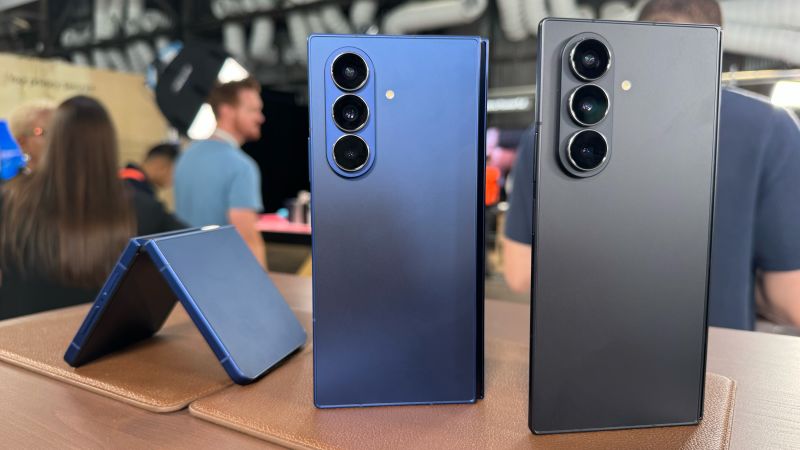On July 25, Samsung officially launched three new foldable smartphones, signaling its dedication to making foldable technology mainstream within the smartphone market. The company introduced the Galaxy Z Fold 7 priced at $2,000, the Galaxy Z Flip 7 at $1,100, and an additional budget model, the Galaxy Z Flip 7 FE priced at $900. These releases aim to capitalize on a growing interest in foldable devices, with pre-orders commencing on July 9. This strategy is an integral part of Samsung’s vision for the future of mobile technology, especially as it intensifies competition against rivals, particularly Apple, who may soon introduce its own foldable iPhone.
Samsung has been the prominent pioneer in the foldable phone segment, trying to invigorate consumer interest in smartphones that offer innovative features such as dual functionality as both phones and tablets. The standard smartphone market has faced stagnation, with recent models lacking significant upgrades that would prompt consumers to make repeat purchases. Foldable phones, while still accounting for a minuscule 2% of the overall smartphone market according to estimations from the International Data Corporation (IDC) and Counterpoint Research, represent an avenue for growth. However, high price points continue to be a barrier for many potential customers. Projections suggest that total global shipments of foldable phones might reach approximately 45.7 million units by 2028—a stark contrast to the expected 1.2 billion conventional smartphones shipped in 2024.
In a recent interview with CNN, Won-joon Choi, the Chief Operating Officer of Samsung’s mobile experience division, expressed optimism about the Fold 7 and Flip 7’s potential to tip the scale towards mainstream acceptance of foldable technology. He emphasized that Samsung has made considerable advancements in design, weight reduction, and internal display technology to appeal to a broader audience. Notably, the Galaxy Z Fold 7 boasts an 8-inch internal display—larger than its predecessor’s 7.6-inch screen—while also being lighter than Samsung’s flagship non-foldable device, the Galaxy S25 Ultra. The Galaxy Z Flip 7 offers a substantial 4.1-inch external display that spans the front when closed and an internal display measuring 6.9 inches.
While Samsung remains a leader in the foldable market, it faces increasing competition primarily from Chinese firms such as Huawei, Vivo, and Honor, who have successfully dominated foldable phone sales in China, the leading market for such devices. The recent announcement by Huawei regarding a foldable model that bends at two points like an accordion reflects not only innovation but also the rapid pace at which competitors are advancing. Notably, Honor also unveiled its slim foldable model, the Magic V5, just prior to Samsung’s launch, demonstrating the intense competition in this niche market.
In an effort to drive sales of its flagship foldables, Samsung introduced the Galaxy Z Flip 7 FE as a more affordable option. Nevertheless, the Galaxy Z Fold 7 has seen a price increase of $100 compared to last year’s model. Choi clarified that these adjustments in pricing stem from significant hardware upgrades rather than external factors like tariffs. Despite industry speculation that foldable phones would eventually become more affordable, analysts suggest that companies have found profitability even at current price points. For instance, Francisco Jeronimo, an IDC analyst, indicated that premium foldable devices continue to present a lucrative segment for Samsung and other manufacturers.
Looking ahead, Samsung is heavily investing in hardware improvements and artificial intelligence (AI) advancements in an attempt to differentiate its products in a growing market. New processors are being utilized for the Galaxy Z Fold 7 and Galaxy Z Flip 7, each optimizing for performance while addressing supply chain challenges. Notably, Samsung is moving away from its traditional strategy of implementing identical CPUs for both devices. Moreover, the collaboration with Google on enhancing the functionality of its AI assistant, Gemini, with foldable models suggests a keen focus on intertwining technology and consumer experience.
Choi expressed the company’s anticipation of a fundamental evolution in how smartphones work—envisioning a future where AI assistance takes the forefront in navigating tasks rather than traditional app-centric operations. “We believe significant changes are on the horizon,” he stated, conveying the company’s commitment to pioneering new paradigms within mobile technology. The momentum behind foldables, paired with advancements in smart technology, indicates an exciting trajectory for both Samsung and the broader mobile industry, shaping the versatility and functionality of personal devices for years to come.











